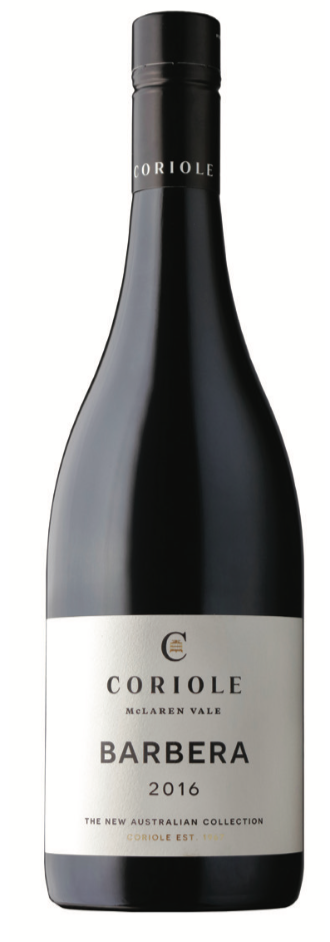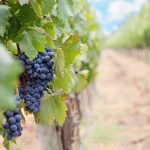By Mark Lloyd, Coriole, McLaren Vale, South Australia
First published in the November/December 2017 issue of the Wine & Viticulture Journal

 Barbera is a variety with distinctive structural elements that set it apart from other varieties. It is medium bodied but with deep colour. It can have extremely high acidity with modest tannins. Thus the wines are often bright and aromatic while quite soft with fresh acidity.
Barbera is a variety with distinctive structural elements that set it apart from other varieties. It is medium bodied but with deep colour. It can have extremely high acidity with modest tannins. Thus the wines are often bright and aromatic while quite soft with fresh acidity.
All this leads to exciting possibilities when matching the variety with particular foods.
Barbera is grown all around the world. However, the most notable region is in Peidmont in northern Italy in the vicinity of Asti and Alba, just south of Turin. Historically, the variety may have been known as the people’s wine – the wine to consume easily and cheaply compared with the hero of the region, Nebbiolo. However, styles continue to evolve and wines grow in complexity. This may in part be due to the limitations on the volume of Nebbiolo leading to producers looking to put more effort into developing their Barbera styles.
BACKGROUND
Barbera was first planted at Coriole in 1998. We had planted our first new European variety, Sangiovese, in 1985. We were hunting for other varieties that would complement this wine. In 1989 Libby Tassie, from Charles Sturt University, had introduced into Australian quarantine new clones from Italy of each of the varieties Barbera, Nebbiolo, Dolcetto and Arneis. These became available in South Australia in the late 1990s from the Nurioopta Research Station just before it was closed. We had visited and tasted wines in Piedmont where these varieties all have a base. We selected Barbera and Nebbiolo to plant as Dolcetto and Arneis looked as though they may suit a cooler climate.
The first vineyard was established at Coriole with two imported clones – 424 and 84. A third clone was introduced at the same time but destroyed in quarantine presumably due to an inappropriate virus. We planted a third clone, F6V4, which was introduced into the country from Davis California in the ‘60s or ‘70s. However, this performed poorly and was removed. There had also been a clone of Barbera imported into Mudgee, in New South Wales, probably in the 1970s. We never planted this clone.
Libby Tassie supplied the following notes from the original supplier of the clonal material:
“Clone 84; medium vigour and yield, small cluster, high wine quality, moderate acidity, suitable for ageing. Clone 424; high vigour and yield, medium large cluster, high wine quality, suitable for ageing.”
The first few vintages were deemed not to be standalone wines as they showed some green characters and lack of texture.
Finally, the first Coriole Barbera was released from the 2004 vintage.
VITICULTURE
Coriole has two Barbera vineyards. The first is at Coriole. This site is not ideal. Vines are on a west-facing slope and the soils are rather bony with pebbly ironstone and clay. The depth of soil varies along the row. This site is frequently mulched with compost. Vines are pruned on a fixed cordon to about 8-9 spurs per metre. The aim with this vineyard is to get good early growth and sustain the vigour of the small block. Vineyard floor management has moved to mechanical weeding and cultivation of every second row. With this combination we hope to achieve the balance of growth required.
Barbera can be a vigorous grower with a tendency for a ‘down-right’ habit. Pruning is to a single cordon with vertical shoot positioning and two sets of lifting wires used.
The second vineyard, grafted onto Shiraz around 10 years later, is situated at Sandalwood against the hills at McLaren Flat. This site is a little cooler and more protected with deep red alluvial soils with rows running down the hill from south-east to north-west. Growth can be extremely vigorous. Again, a combination of mechanical weeding, cultivation, preferential irrigation, if any, and a natural sward is used to try and get the balance of the vine we require.
Barbera is thin skinned with large bunches. It is prone to heat stress with bunches collapsing even if enclosed in a protected canopy. Two out of three vintages are excellent. McLaren Vale can really deliver a high quality wine getting a great balance of extract and flavour and featuring the excellent characteristics of the variety with wines winning gold medals. However, the required quality cannot always be guaranteed. We occasionally take some fruit from a vineyard in the Adelaide Hills just a short distance away and yet around 200-300 metres higher. The condition of this fruit is more reliable although it doesn’t always demonstrate the good features that are available in the McLaren Vale region.
WINEMAKING
Barbera ripens two to four weeks after Shiraz. Fruit is picked based on flavour and conditions. Acid is also extremely high so this is also taken into account when picking decisions are made. A typical analysis at picking is 14-14.5 Be, 3.2 pH and 10-11 TA. Malic acid is, of course, high so acid does show a little more balance at the end of fermentation. However, levels remain high at over seven grams per litre.
Fairly standard winemaking applies.
Fruit is destemmed and pumped to open fermenters. Fermentation is run at a steady temperature for six to eight days to dryness with gentle extraction. Wines complete a natural malolactic ferment and then often pressed to wood. The high acid and low tannin of Barbera raises the possibility of using a small proportion of new oak to advantage. This helps if the wine is to be aged but in some vintages can be useful for achieving a wine with good balance. There are also good opportunities for co-fermentation and blending with other varieties.
BARBERA

By Peter Dry Emeritus Fellow, The Australian Wine Research Institute
BACKGROUND
Barbera (bah-BEH-rah) is a red grape variety said to have originated in central Piedmont, however, DNA analysis reveals that it has little relationship with other varieties of Piedmont. Therefore, its origin may have been elsewhere as a natural cross. The first reliable reference to Barbera was at the end of 18th century near Asti, but it did not become important in Piedmont until after the arrival of phylloxera. Nevertheless, it is now said to be most ‘typical’ variety of Piedmont, comprising one-third of the regional planted area. It is also prominent elsewhere in northern Italy (Lombardy, Emilia-Romagna), and a little is grown in the south. Synonyms include Barbera a Peduncolo Rosso, Barbera a Ruspo Verde, Barbera Amaro, Barbera d’Asti, Barbera Fina, Barbera Grossa, Barbera Nera, Barbera Nostrana, Barbera vera, Berberone, Gaietto, Lombardesca and Sciaa. Barbera Bianca and Barbera de Sannio are not genetically related. The global area of Barbera is 24,178ha (2010) of which 85% is in Italy—but there has been a significant decrease since the mid-1980s. California has 2798ha, where it has been popular since the 1970s, particularly in the hot inland San Joaquin Valley. It is also important in Argentina. There are small areas in Slovenia, Greece, Israel and South Africa. Australia has 116ha (2010) and at least 101 wine producers, mainly in the Hunter Valley, McLaren Vale, King Valley, Adelaide Hills and Barossa Valley.
VITICULTURE
Budburst is early to mid-season and maturity is mid-season. Vigour is moderate with a semi-erect growth habit. Bunches are medium and can range from well-filled to compact with medium berries. Yield is moderate to high. Cane pruning is most often used in Italy but spur pruning is successful in Australia. Barbera is moderately susceptible to mildews and bunch rot.
WINE
Barbera wines have high acidity, good colour and tannin. Descriptors include spice, nutmeg, cherry, mulberry, plum, liquorice and freshness. It is used for both dry and sweet red wines and sparkling in Italy—best known in DOCG wines of Barbera d’Asti (allows up to 15% of Freisa, Grignolino or Dolcetto), and DOC wines Barbera d’Alba and Barbera di Monferrato. It is useful in blends for contribution of acidity.




















